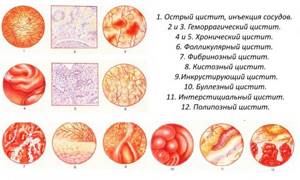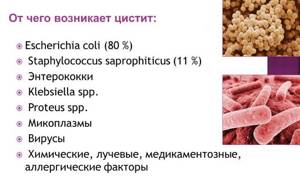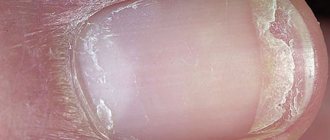A bladder disease characterized by inflammation of the walls is called cystitis. In most cases, it affects women, the reason is the anatomical features of the structure of the urinary system. Almost every girl has encountered it at least once in her life, but some have to treat cystitis almost every month. What to do, and what could be the reasons for this manifestation of the disease?
In most cases, cystitis affects women, the reason is the anatomical features of the structure of the urinary system.
Nature of cystitis
Most people believe that cystitis is an infectious disease and that the pathological process is based on infection by microorganisms. How does this happen? It is very easy for bacteria to get into the bladder from a woman’s external genitourinary organs, since their urethra is wide and short. Having climbed along it, the microorganism enters the mucous membrane of the walls, which causes the onset of the inflammatory process.
The causative agents may not necessarily be harmful bacteria. In other environments, such as the intestines, they may even be beneficial and participate in the digestive process. These can be various microbes such as streptococci, staphylococci, enterococci, salmonella and protea. Vaginal bacteria such as Candida can also be the causative agent.

Cystitis can be infectious or non-infectious; they differ in the way microorganisms and viruses enter the bladder or are caused by other factors.
This is an ascending route of infection, but infections can enter the body in other ways. The second most common method is descending, that is, from the upper organs to the lower ones. This means that microorganisms or viruses entered the bladder from the kidneys and ureters located above.
The infection can also come through the blood. Sometimes a simple sore throat is enough for cystitis to begin. In most cases, rarely will anyone associate ordinary tonsillitis or dysbiosis with inflammation of the bladder, but sometimes they are the cause. There is another way for infectious agents to enter the organ - through the walls of the bladder from nearby foci of inflammation, that is, from the pelvic organs. This happens especially often in men, but women are no exception.
The ways in which microorganisms and viruses enter the bladder were listed above, i.e. the infectious nature of the inflammation was considered, but there are also non-infectious cystitis. And the reasons for their occurrence may be different.
- Medicinal cystitis, or chemical. It is caused by medications taken (chemotherapy, analgesics, antibiotics) and agents that create an unfavorable environment in the bladder, irritating the walls of the organ and causing an inflammatory process. To treat it, it will be necessary to discontinue a certain drug and replace it with an analogue that will not harm.
- Allergic cystitis. With this form of the disease, symptoms may appear only after using certain hygiene items (bath bubbles, intimate gels, spermicidal ointments) or eating certain foods.
- Thermal cystitis. It occurs when, during the procedure of flushing the bladder or other manipulations involving the introduction of solutions into the organ, too hot a liquid is poured.
- Interstitial cystitis. The nature of its appearance is not yet fully understood, but the disease develops very slowly and severely deforms the walls of the bladder.
- Cystitis due to mechanical damage to the walls of the organ. The cause is urolithiasis.
As it becomes clear from what is written above, a correctly diagnosed cause of the disease is 50% of success in treatment. So it would be useful to familiarize yourself with the secondary factors that can provoke this disease, especially its chronic forms.
Causes of cystitis in women
Before we move on to identifying the cause of cystitis, let’s understand how it manifests itself.
Symptoms of cystitis in women:
- painful urination;
- pain in the lower abdomen;
- a feeling that the bladder is still full after urinating;
- urinary incontinence;
- change in urine color to a cloudy, reddish hue.
Causes of cystitis in women:
- Hypothermia of the pelvic area.
- Injury to the mucous membranes of the bladder.
- Sedentary, especially sedentary lifestyle.
- Poor diet, rich in fatty and spicy foods.
- Gynecological and venereal diseases.
- Unprotected sexual intercourse.
- Poor hygiene.
The symptoms of cystitis in men are the same, the only difference is an increased burning sensation when urinating, as well as the presence of mucus in the urine. The causes of cystitis in men have a number of differences from women:
- It often develops against the background of concomitant diseases (prostatitis, epididymitis).
- Complications of diseases such as purpura, schistosomiasis.
- Most often caused by chlamydia, trichomonas and gonococcus.
The causes of acute cystitis in women are mainly opportunistic flora penetrating from the vagina or intestines. These are Escherichia coli, Proteus, and Candida fungi. But sometimes cystitis occurs due to pathogens: gonococcus, herpes, trichomonas, and chlamydia.
Manifestations of acute cystitis may disappear on their own within three days. This is due to the fact that the body’s protective functions come into play, and the general condition remains satisfactory, there is no increase in temperature or weakness. But at the same time there is:
- urinating too frequently;
- sharp pain in the perineum;
- the presence of blood in the urine or a change in its color;
- nausea.
Sometimes a violation of the integrity of blood vessels can explain the causes of cystitis with blood, which is frightening and causes a lot of inconvenience. As you can see, the causes of cystitis in women can be prevented by following simple rules.

Prevention
- In the midst of cystitis, you need to drink plenty of water - 1 glass of water every 2-3 hours. Goal: Drink enough so that you only need to urinate once an hour.
- Every time you go to the toilet, you should empty your bladder completely. It is also advisable to do this before and immediately after sexual intercourse.
- To prevent E. coli from entering the urinary tract, you need to wash your genitals with a hand movement from front to back. The same movement should be done when using toilet paper.
- Hygiene is important for the health of every woman, but with cystitis it is doubly important. You should wash your genitals with water at least once a day, and during menstruation - several times a day. Before sexual intercourse, both partners should wash their hands and private parts. Before touching her genitals, women are advised to wash their hands with soap to prevent infection.
- During menstruation, it is advisable to change pads more often, no matter how well they absorb discharge. Blood on pads is a breeding ground for microbes; in addition, the pad itself becomes a bridge from the anus to the mucous membrane of the urinary tract, along which microbes travel.
- Before a woman inserts any object into the vagina, make sure that it has enough lubrication.
Cystitis after sex (postcoital) prevention
If you experience frequent exacerbations of cystitis after sex, you should discuss preventive measures with your doctor.
Today, in such cases, it is recommended to take an antibiotic or sulfonamide tablet after sexual intercourse. This measure avoids infection, but does not lead to side effects typical of long-term use of antibiotics. Inflammation of the urinary tract and birth control pills, condoms
If you experience frequent inflammation of the urinary tract, you should consider changing your contraceptive method.
Cystitis is more common in women if she takes birth control pills. The same problem sometimes appears when using a vaginal diaphragm and suppositories, as well as colored condoms. Sports, cycling
Is it possible to play sports with cystitis? During an exacerbation, of course not. When playing sports and physical activity, you should wear loose clothing and drink enough water. Tight trousers, as well as cycling, create conditions for exacerbation of the disease.
Diet and nutrition
Caffeine and alcohol irritate the bladder and therefore worsen the course of the disease. It is advisable to consume less of these drinks or at least wash them down with plenty of water. During inflammation of the urinary tract and for prevention, it is useful to drink cranberry juice. It contains hippuric acid, which prevents microbes from attaching to the walls of the bladder. It is recommended to drink up to 4 glasses of unsweetened cranberry juice per day. You can also add fresh or thawed cranberries to organic yogurt. But it is better to exclude hot seasonings, including pepper, from the menu. Sugar, white rice, pasta and white flour bread contribute to the development of microbes and aggravation of cystitis. They need to be consumed less.
07.05. 2012
( 18 ratings, average: 4.39 out of 5)
Treatment of cystitis with folk remedies
Read also Vasculitis - symptoms, causes, types and treatment of vasculitis
Many, many people have been helped by folk remedies in the treatment of cystitis. Let's look at some of them.
Warming up
Before warming up, it will be good if you steam your legs, and then, after wrapping yourself up, apply a heating pad to the bladder area.
Salt. Heat table salt in a frying pan and pour into a sock. Apply it like a heating pad to your lower abdomen and crawl under the blanket.
Buckwheat, millet, rice. Do the same as with salt.
Water bottle. Fill a plastic bottle with hot water, apply it to your lower abdomen and wrap yourself up.
The warming process should be pleasant, so if the heating pad is very hot, place a cloth under it.
Baths
With sea salt. Fill the bath with water and add sea salt.
With essential oils. Add 2 drops each of eucalyptus, sandalwood and juniper oils to the bath water and sit for 10 minutes.
Juniper essential oil is contraindicated during pregnancy.
With chamomile. Brew 3-4 tbsp in boiling water. spoons of chamomile and pour into a bowl, stirring with warm water. Sit in this bath until it cools down, but remember that the water should not be too hot. You can make the same bath with calendula or add calendula to chamomile.
With iodine. Fill a bowl of hot water and pour in some iodine. Sit over the bath for 10-15 minutes.
With milk. Heat the milk to such a state that you can sit in it, take it until it cools down.
Decoctions
Chamomile. Pour 1 tbsp. spoon of chamomile 1 glass of boiling water. Take 20 ml 3 times a day.
Read also Atopic dermatitis - symptoms, causes and treatment of atopic dermatitis
St. John's wort. 1 tbsp. Pour 1 cup of boiling water over a spoonful of St. John's wort. Boil for 10-15 minutes and strain. Take 50 ml 3 times a day.
Sage. 1 tbsp. Pour a spoonful of medicinal sage into 1 cup of boiling water and boil for 30 minutes in a water bath. Cool and add hot water if necessary until you get 1 cup of liquid. Take 50 ml 3 times a day 30 minutes before meals.
Lingonberry leaves. Pour 1 cup of boiling water over 2 teaspoons of lingonberry leaves and boil for 10-15 minutes. Let the broth steep for at least 2 hours. Strain and take 100 ml 4 times a day before meals.
Yarrow. Brew 2 teaspoons of yarrow with 1 cup of boiling water. Let stand for 1 hour and strain. Take a quarter glass 4 times a day.
Special forms of pathology
Along with a large number of forms, experts highlight those that deserve special attention. These include interstitial cystitis. In this form, the pathological process extends not only to the mucous membrane, but also to the submucosa and even the muscular layer. As a result, the walls atrophy, and the organ itself sharply decreases in size. The frequency of urination reaches 150 times a day. Considering that the reasons for the appearance of this form have not been fully identified, the only treatment today is surgery, in which the bladder is removed and plastic surgery is performed from the area of the colon.
As already mentioned, cystitis is more common in women, but in men it is often caused by prostatitis. In the presence of a pathological process in the prostate, the patency of the ureters is disrupted, which is why urine accumulates in the bladder, which causes inflammation. At the same time, the clinical picture is poorly expressed and only urine tests can detect cystitis. As a rule, to eliminate this problem, it is enough to treat the underlying disease.

In addition, there is a direct connection between cystitis and sexually transmitted infections. Often, infection with some diseases occurs unnoticed, and the course is characterized by the absence of symptoms. As a result, the woman does not pay attention to the infectious process. If this situation lasts for a long time, then a chronic form is formed, which negatively affects the body's resistance. In this case, all surrounding organs begin to suffer, including the bladder. In this situation, a woman has a question: which doctor should she contact, since they are primarily concerned about cystitis, although to eliminate the problem they need to get rid of the cause, that is, a sexually transmitted infection.
A special form is defloration cystitis. During the onset of sexual activity, a large amount of “new” flora enters the vagina. It also penetrates the bladder in an ascending manner. As a rule, it manifests itself as unexpressed pain and increased frequency of urination, as a result of which the woman simply does not pay attention to it or hopes that it will go away on its own. This leads to the progression of the pathology, and undetected cystitis threatens complications from both the kidneys and the genital organs.
Cystitis especially often appears or worsens during pregnancy. Naturally, every woman is interested in why and what causes cystitis in a given period of life. There are many reasons for this: hormonal changes and fetal pressure on organs, as well as decreased immunity. An exacerbation may occur in the second trimester, when the uterus begins to grow. Also, the disease often appears at the beginning of pregnancy from hypothermia, decreased immunity, and so on. A particular difficulty is that in this situation the therapy will be very different from all other cases, since the drugs should not adversely affect either the condition of the mother or the health of the fetus. Therefore, in order to ensure that the consequences of such a pathology are minimal, it is better to take measures in advance, that is, prevention during pregnancy comes first.
Clinic and possible complications
Knowing what causes this pathology and what forms occur, you should understand exactly how it occurs. The most common syndromes are increased frequency of urination, burning sensation, frequent urge in the morning, discomfort in the groin area, change in urine odor, turbidity, and impaired sphincter contractility. In addition, nausea due to cystitis, pain in the lower abdomen, increased body temperature, and discharge of drops of blood or pus are possible. If the last signs appear, you need to go to the doctor as soon as possible.
In very rare cases, swelling is possible, but, as a rule, this indicates the spread of the process to the kidneys. But diarrhea may indicate an intestinal infection, which also provokes cystitis.
In the absence of treatment or if there are residual effects, complications in the form of pyelonephritis are possible. Particular attention should be paid to interstitial cystitis, as it requires surgical intervention.
First aid for inflammation
Of course, the first thing you need to do is see a doctor, especially for pregnant women, as hospitalization may be required. But if for some reason this cannot be done, you can independently relieve the acute symptom and thereby improve the patient’s condition. At the same time, these recommendations are only suitable for those who know exactly the cause of the pathology, that is, cystitis has already been diagnosed.
To begin with, you can use no-shpu. It will relieve spasm and improve urine flow. In addition, this will reduce pain. Some believe that the best treatment is phytolysin. This is explained by the fact that this drug is of plant origin and has a small number of side effects. In addition, often those who are tormented by cystitis use monural, but they should drink it according to strict rules. This allows you to get rid of the first signs, but after that you need to see a doctor and get tested.
The methods of treating cystitis are described in the video:
Features of diagnosis and treatment
In order to make a correct diagnosis, it is enough to take tests. This is a general urine test with bacterioscopy of sediment and blood. In addition, a study is carried out for sexually transmitted infections, hidden pathologies, tuberculosis, and so on. As already mentioned, frequent cystitis is often observed in women with a chronic infection of the genital organs. Therefore, even if she is sure that there are none, she needs to check all possible paths and understand where the pathogen comes from in the pelvic organs. Sometimes you additionally prescribe an ultrasound, the photo of which can reveal the bullous or interstitial form.
Knowing how to identify cystitis, you can easily choose treatment. In this case, it is important to identify the cause, that is, the presence or absence of the pathogen. Based on this, drugs that are active against it are selected. At the same time, you should not hope that the pathology will go away on its own, even if you take azithromycin on your own for cystitis. The use of antibiotics and other drugs without a doctor is dangerous, first of all, due to complications, since the cause of the disease may be completely different bacteria, against which the drugs used simply do not work. As a result, the pathological process is not stopped, and the body suffers from the side effects of the drugs.
The only sure option is to consult a doctor, from whom you can ask what to do and how to be treated. Of course, in addition to traditional medicine, you can also use alternative treatment for a disease such as cystitis; reviews, as a rule, help you select such drugs. As a rule, treatment is carried out on an outpatient basis, but in some cases a sick leave may be issued, especially for purulent forms, patients during pregnancy and in a number of other cases.
Relieving acute pain at home
Take a glass bottle with a capacity of 500 ml, fill it with very hot water (but not boiling water, the temperature should be 45-50 degrees), close it tightly with a stopper and apply it to your stomach in the pubic area, holding it between your legs. Attention! If the bottle is too hot, wrap it in a cloth. And also check the plug - otherwise the water will spill out and burn you. When the water cools down, repeat the procedure - fill it again with hot water. Pain relief from cystitis occurs an hour or two after using such a heating pad. However, this will only relieve the pain and will not kill the infection. Do not forget! Usually the disease goes away quite quickly. But if the duration of cystitis prolongs, the urge becomes very frequent and is accompanied by chills, high fever, vomiting, and lower back pain, you need to be wary. This may be a sign that the infection has spread upward, from the urethra and bladder to the kidneys. The inflammatory process of the kidneys, pyelonephritis, causes serious complications, so if such symptoms occur, you should immediately consult a doctor and begin treatment. Alas, cystitis in women is a type of disease that easily turns chronic. To reduce this risk and avoid another exacerbation, a number of measures should be taken.











